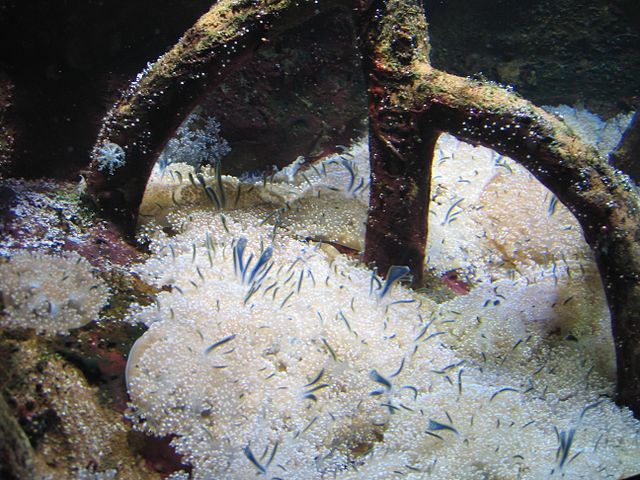 |
| Cassiopeia xamachana - Wikipedia |
This species is prevalent in shallow, warm tropical waters such as mangrove swamps. They are often called mangrove jellyfish because they are frequently found in large aggregations in these swampy regions. Unlike many species of jellyfish, upside down jellies are completely marine. None have been found in brackish or fresh waters.
These jellies spend their lives completely differently than most jellyfish. Jellyfish typically spend much of their time drifting freely on the ocean's currents. Upside down jellyfish are free swimming until they reach about 2 cm. Then their bell inverts and they sink to the bottom of the ocean floor. From there they will spend the majority of their adult life upside down on the muddy substrate with their tentacles pointed up to capture the ever-present zooplankton from water columns.
Much like blue jellies, upside down jellyfish have a symbiotic relationship with zooxanthellae. This is the same symbiosis that occurs with many jellyfish and coral species. In addition to providing essential nutrients, these golden algae also produce oxygen to help support respiratory metabolic functions the jellyfish needs to survive in oxygen-poor environments. This is of particular importance to upside down jellyfish because they spend the vast majority of their life nestled in muddy substrate and must rely on their food to come to them. Because of their specialized eating habits, upside down jellyfish are usually found in nutrient-rich waters with high concentrations of decaying matter to support the zooplankton teaming within these swampy, saltwater environments.
Upside down jellies have flat, saucer-shaped bells. Their umbrellas are typically greenish grey or blue in colour. They have a central depression or exumbrella in their bell. The exumbrella acts as a suction device to help them stay anchored to the ocean floor. Rather than a single mouth opening, they have 4 elaborately branched oral arms. These arms have a frilly, lace-like appearance similar to many green, leafy vegetables. They are often referred to as cabbage-head jellyfish because of these appendages. It is believed that this species a filter feeder and also relies on some form of absorption of dissolved nutrients directly from the water to supplement its nutritional needs.
Upside down jellyfish do not directly inject their prey like most jellyfish do. Their nematocysts (stinging cells) are controlled by the cnidocil. This is the equivalent to a mechanically or chemically triggered grenade launcher. The stinging cells launched from the cnidocil produce a cnidoblast that will stun or paralyze prey in the immediate vicinity. The jellyfish then begin ingesting their prey with their primary mouth openings. Once the prey is reduced to food fragments, these nutrient particles are passed on to secondary mouths for further digestion.
The jellyfish's cnidoblasts also function as a self-defence mechanism. If abruptly disturbed, large groups of these jellies will launch themselves upward from the ocean floor and release their nematocysts. This massive venom release into the water is usually sufficient to ward off potential predators. The toxic compound is generally inconsequential to human beings. It may result in an itchy or tingling sensation of the skin or a rash on individuals more sensitive to the venom.
Upside down jellyfish can reach up to 14 inches in diameter in the wild. In captivity, a maximum growth potential of 8 inches is more realistic. Depending on their size in captivity, upside down jellyfish can be fed zooplankton, or small invertebrates and fish. In order to allow their symbiotic algae to properly photosynthesize, a lighting system conducive to a marine reef tank is highly recommended. These jellies have a higher temperature tolerance than most scyphozoan medusa. Medusae or adult jellyfish can be found year round. However, the optimum temperature for these adult jellies is between 75-78 F. This simulates the height of the adult season. Upside down jellyfish typically strobilate during summer or early fall. Whereas most scyphozoans strobilate during the winter months.
Technological advancements in the aquarium industry continually redefine the concept of "home aquarium owner." Just twenty years ago not even the biggest public aquarium was capable of keeping jellyfish alive in captivity. Now they make desktop Jellyfish Fish Tank Aquariums. And why would you want a jellyfish tank? Perhaps you should check out what the translucent bodies of Pet Moon Jellyfish look like under LED lighting. Pet Jellyfish give a whole new meaning to the term exotic pets. Article Source: EzineArticles |

No comments:
Post a Comment